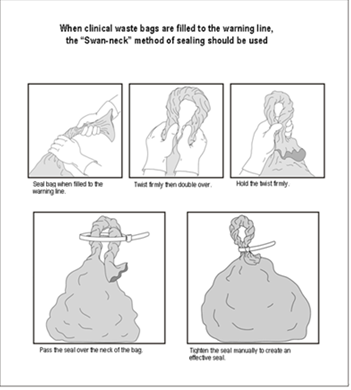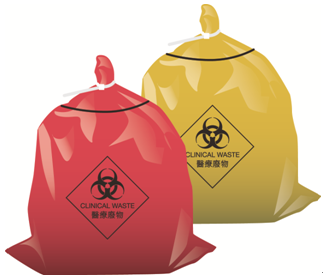Segregation, Packaging and Labelling of Clinical Waste for Major Producers
Segregation
Clinical waste should be segregated from municipal solid waste or other waste streams at the point of arising. Different groups of clinical waste should be handled differently according to their packaging requirements as specified in the Code of Practice. A sufficient number of appropriate and dedicated containers for holding clinical waste should be placed adjacent to the locations where clinical waste is generated so as to facilitate the segregation.
Clinical waste should be put into appropriate containers as quickly as possible so as to avoid contaminating other materials and to minimize potential human exposure. Containers for holding clinical waste should be covered by secure lids.
Packaging
General Requirements
Clinical waste must be placed in containers that are leak-proof, impervious to moisture and strong enough to prevent tearing or bursting under normal handling. Such containers should be of one-trip type and should not be reused. They should be capable of being sealed in a manner that can prevent spillage of the contents during transportation.
The containers should be in good condition and free from contamination, damage or any other defects which may impair their safe and secure use. A waste producer should carry out visual inspection of such containers to determine their condition before they are used.
Types of Containers
Different groups of clinical waste should be placed in the appropriate types of containers in accordance with Table 1. All containers should be securely closed and sealed in accordance with the Code of Practice before collection.
Group 1 clinical waste should be put into sharps boxes. Group 2, 3, 4, 5 and 6 clinical wastes should be put into either heavy duty plastic bags or plastic drums that are strong enough to hold the waste without any leakage or breakage. Plastic drums should be used for clinical waste containing liquids.
Group 2, 4, 5 and 6 clinical wastes may be placed together in the same bag/drum. Group 3 clinical waste should be placed in separate bags/drums and should not be mixed with any other groups of clinical waste.
Table 1: Packaging Requirements for Different Groups of Clinical Waste.
| Groups of Clinical Waste | Type(s) of Container | Colour | Sealing |
|---|---|---|---|
| Group 1 - Used or contaminated sharps | Sharps box | YELLOW or combination of WHITE and YELLOW | Proprietary closure |
| Group 3 - Human and animal tissues | Heavy duty plastic bag | YELLOW | Plastic tie |
| Plastic drum | YELLOW | Proprietary closure / tape | |
|
Group 2 - Laboratory waste Group 4 - Infectious materials Group 5 - Dressings Group 6 - Other wastes |
Heavy duty plastic bag | RED | Plastic tie |
| Plastic drum | RED | Proprietary closure / tape |
Specifications for Different Types of Containers
The design, materials and construction of different types of containers for clinical waste should follow the specifications set out in Code of Practice. Read More.
Colour-Coding of Packaging
To enable easy and unique identification of clinical waste which is essential for subsequent handling by licensed collectors and operators of licensed disposal facilities, the packaging of clinical waste should follow the colour-coding specified in Table 1.
Sealing of Containers
Containers of clinical waste should not be filled above the warning line indicating between 70% and 80% of their maximum volume before sealing. The packaging and sealing should be conducted with care to ensure that no clinical waste adheres to the external surface of the containers.
Sharps boxes should be properly sealed by the proprietary closure whereas plastic drums by the proprietary closure or tape as appropriate. Plastic bags should be sealed by tying the neck securely to prevent spillage. The swan-neck sealing method as shown in Figure 1 is recommended.
|
Figure 1: Sealing Method for Clinical Waste Bags. |
No staple or unprotected metallic wire tie should be used for sealing or tagging of plastic bags with clinical waste, so as to prevent injury to waste handlers and damage to other bags. Metallic wire tie fully wrapped with plastic is acceptable for use in sealing plastic bags.
Plastic drums containing clinical waste with liquids should be securely sealed to prevent spillage. Absorbent materials may be added into the containers to prevent seepage of liquids as appropriate.
Labelling
Every container of clinical waste must bear a label as specified in Code of Practice. The label must be securely affixed or pre-printed on a prominent position of the container which allows the information on the label to be read easily. It is recommended to affix or pre-print a label on each of the opposite sides of the container wherever practicable.
|
Waste bags with pre-printed Clinical Waste label |
In addition, each container should be marked using BLACK indelible ink, or a tag should be securely attached, to show the origin of the waste (i.e. the name and address of waste producer) and the date of sealing.
If a bag holder (e.g. an ordinary type rubbish bin) is used for holding the plastic bag which is in use, it should be in good condition and should follow the same labelling requirements as for the plastic bag itself. The colour of the bag holder should preferably be the same as that of the bag for easy identification. Read More.
Special Considerations for Handling Chemical Waste Arising from Medical and Dental Sources
Certain clinical waste may contain chemical residues which are classified as chemical waste. In such cases, the chemical residues should be segregated from the clinical waste at source wherever it is practicable. For example, broken thermometer containing mercury should be segregated from other clinical waste. Chemical waste arising from medical and dental sources does not fall within the definition of clinical waste. Disposal of such waste is subject to the Waste Disposal Ordinance and the Waste Disposal (Chemical Waste) (General) Regulation.
If the chemical waste contains or is contaminated with any clinical waste, pre-treatment measures should be taken as far as practicable to render the waste non-infectious before it is collected by a licensed chemical waste collector.


